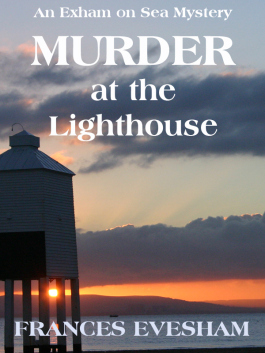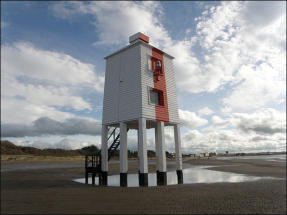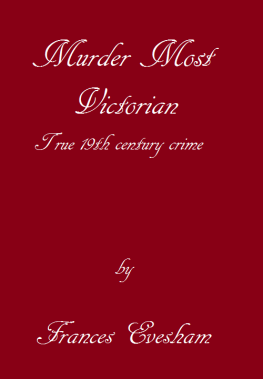Frances Evesham's Blog, page 3
May 2, 2016
The Exham on Sea Mysteries: Book Three
Filed under: cozy mystery, fiction, murder, mystery, Novel, Uncategorized Tagged: crime, Frances Evesham, Francis Evesham, murder, mystery, romance








May 1, 2016
The Exham on Sea Mysteries: Book Three
Filed under: books, cozy mystery, murder, mystery, Novel, Uncategorized Tagged: communication, Frances Evesham, Francis Evesham, murder, mystery, romance








November 1, 2015
Five Fun Facts: a Unique Lighthouse
The Unique Nine-Legged Lighthouse at Burnham on Sea
Nine wooden legs
The waters of the River Parrett meet the Bristol Chann el at Burnham on Sea. Notoriously dangerous, with a huge range of 40ft, the tide in the area is the second highest in the world. The builders of the nine-legged Low Lighthouse also had to contend with shifting sands and mud-flats that would soon destroy the foundations of a conventional stone building. Wooden stilts were an ingenious solution that make the lighthouse unique in the UK.
el at Burnham on Sea. Notoriously dangerous, with a huge range of 40ft, the tide in the area is the second highest in the world. The builders of the nine-legged Low Lighthouse also had to contend with shifting sands and mud-flats that would soon destroy the foundations of a conventional stone building. Wooden stilts were an ingenious solution that make the lighthouse unique in the UK.
Victorian ingenuity
The Victorians built the Low Lighthouse in 1832, a time of enormous interest in technology and travel, to replace the Round Tower. This was a tall building originally situated next to the Church, funded by the local curate on condition the Burnham fishermen and residents paid for its upkeep.
The Low Lighthouse fell out of use in the 20th century but was recommissioned in 1983 and now flashes every 7.5 seconds.
Leading lights
The Victorians built another lighthouse, the Tower or High Lighthouse, at the same time, and the two buildings worked together to lead navigators through the River Parrett. The Tower is now a private house.
Numbers
 The Grade 11 listed Low Lighthouse is a wooden square, constructed on strong oak legs, with a single, dramatic, vertical red stripe. Set at a height of 36ft, the light reaches 23ft above the high spring tides and shines out over 9 miles.
The Grade 11 listed Low Lighthouse is a wooden square, constructed on strong oak legs, with a single, dramatic, vertical red stripe. Set at a height of 36ft, the light reaches 23ft above the high spring tides and shines out over 9 miles.
Murder at the Lighthouse
The Low Lighthouse stars in the first Exham on Sea Mystery. Libby Forest finds a body on the beach under the lighthouse and discovers her unexpected gift for investigation, helped by Bear, the gigantic Carpathian Sheepdog and Fuzzy, her aloof marmalade cat.
Read more about the Exham on Sea Mysteries…
More facts and figures about the Burnham on Sea lighthouses at the uklighthouse website
Filed under: 19th century, cozy mystery, frances evesham, history, story Tagged: 19th century, Frances Evesham, Francis Evesham, fun facts, history, lighthouse, unique, Victorian








October 17, 2015
The Duel: gentlemanly solution or murder?
Hear about a duel, and you imagine glamorous Georgian gentlemen politely settling their differences. Whatever the cause, there’s no denying the romance of the idea. Since the 17th century, a fight between two men, conducted in a gentlemanly manner, was an acceptable way of settling a disagreement over debts, cheating at cards or stealing a lady’s affections.
Murder
In 19th century England, law and order was beginning to take hold: the Metropolitan police were established in London in 1829. By then, killing a man in a duel was murder. However, the police found it difficult to successfully prosecute.
A military affair
On 1 July 1843, one of the last duels in England took place between Colonel David Lynar Fawcett of the 55th Regiment and his brother in law, Lieutenant Alexander Thompson Munro, of the Royal Horse Guards, who was married to Colonel Fawcett’s sister.
The full reason for their dispute is unclear, but it appeared to be about family property or, possibly, an insult to Mrs Fawcett.
The separate trials of Lieutenants William Cuddy and Duncan Grant, for the murder of Colonel Fawcett, highlight the difficulties facing the police and courts in establishing guilt for the death of one of the duellists.
Events
Early that morning, Police Constable John Jones saw two carriages, a phaeton and a brougham, collecting a total of five gentlemen and heading to the toll-gate near the Brecknock Arms in Camden.
Edward Davis, the toll-keeper, watched as the gentlemen walked away in separate small groups, into the fields. Ten minutes or so later, two returned and left the scene in a carriage. Mr Davis maintained he heard and saw nothing of note during the events that led to Colonel Faucett’s death, although after 15 minutes or so he went over to the scene and summoned PC Jones for help.
The crime scene
Jones found Colonel Fawcett on the ground in the field, accompanied by two other men. One was George Gulliver, a surgeon in the Royal Horse Guards. The other was unknown to Jones.
Death
The colonel was taken to the Brecknock Arms, but was refused entry and the party had to travel on to the Camden Arms. A surgeon was sent for and attended him there, but a bullet had entered the colonel’s chest and he died two days later.
First trial
During the first trial in August that year, Lieutenant William Cuddy was accused of murder. He had accompanied the principals to the field and was believed to have supplied a brace of pistols. However, during his trial, the witnesses had great trouble identifying him.
Gulliver’s evidence
The surgeon, George Gulliver, who had also originally been charged with the offence but released, identified Lieutenant Munro and Mr Grant, but was unwilling to identify Cuddy. He stated that, perhaps rather judiciously, he had momentarily turned away from the group of men when the shot was fired.
In evidence, Gulliver claimed Munro said “Fawcett, I thought you were levelling at me.” To which the colonel replied, “I was not levelling,” perhaps suggesting that Munro fired early.
Gulliver sent Cuddy away from the field, to fetch help. During the trial, he claimed not to be sure that the defendant, Cuddy, was in fact the man at the scene.
Another suggestion
There was a brief attempt to suggest that Fawcett might have shot himself, but the surgeon, Liston, who attended him at the Camden Arms, explained that the man’s arm must have been ‘raised very much,’ perhaps as he levelled his pistol?
Verdict
William Cuddy was acquitted of murder.
Second trial
Lieutenants Grant and Munro had fled the scene and travelled abroad, but Grant surrendered himself in December 1843.
Early the next year, Lieutenant Duncan Grant was duly brought to trial for the murder. Once again, the exact details of the affair were difficult to establish. The livery stable keeper, Mr Holland, from whom Fawcett had ordered a carriage, was unable to identify Grant as the same gentleman he saw with Munro in the phaeton.
A private in the Royal Horse Guards, one Charles Longman, worked for Munro. He was unable to identify two of the other three men involved in the affair, although he recognised the surgeon, George Gulliver. One of the men ‘had moustaches.’
When asked whether the prisoner was the man with the moustaches, seen with Munro, Longman thought the prisoner’s hair was darker.
The toll collector maintained he saw five gentlemen, heard no shots and could not say whether the prisoner was one of the men at the scene.
George Gulliver was also unable to recall seeing Grant at the scene following the shooting, although he had named him as one of the five in the field.
Verdict
Lieutenant Grant was acquitted of murder.
Third trial
Lieutenant Munro was finally tried in 1847.
This time, the surgeon, Gulliver, recalled Munro saying he had no desire to take part in the ‘meeting’, but had been insulted in front of a servant.
Gulliver’s recollection of the words Munro used after the affair had changed a little. He described Munro as saying that Fawcett was, ‘covering me,’ meaning he was deliberately taking aim. Gulliver described Munro in warm terms, as a distinguished officer and the kindest of gentlemen.
Lieutenant Cuddy was called as a witness at Munro’s trial and, after being handed a pardon, ‘under the great seal of her Majesty,’ for his part in the affair, gave an account of the dual.
Cuddy’s evidence
Cuddy had supplied pistols and Lieutenant Grant had given the agreed signal: “Gentlemen, are you ready, fire.” Munro fired instantly. Munro said, “Did you see him, he covered me as dead as possible; he intended to shoot me,” and tried to shake hands with Fawcett, but Cuddy’s view was that hands were not shaken. Munro then said he forgave Fawcett and left the field.
Cuddy, like so many other witnesses in the case, seemed to have difficulty in identifying the participants in the affair. He would not or could not positively identify the prisoner as Munro, saying he had seen him only once since the meeting.
Verdict
Munro was found guilty and sentenced to death, with a strong recommendation to mercy. He was not hanged, but was sent to Newgate prison for a year.
Get your FREE kindle version of Murder Most Victorian and read more stories of true Victorian crime.
Filed under: 19th century, murder, Victorian Tagged: 19th century, crime, duel, Frances Evesham, Francis Evesham, history, London, murder most Victorian, Victorian crime, Victorian murder








August 7, 2015
Guest Blogs and Reviews to Celebrate Danger at Thatcham Hall, my New Historical Mystery
Danger at Thatcham Hall, the second Thatcham Hall Mystery, is now published and available world-wide. To celebrate the launch of this historical cozy mystery I’ve written several blog posts for colleagues, and I’ll post links to them here as they appear, along with links to reviews.
Links to guest posts
How To Sell More Books on Work From Home Wisdom.
Interview with Jana Richards a writer of romance, on her blog.
Links to Reviews of Danger at Thatcham Hall
A Reader’s Perspective by Vanessa Wester: “I really enjoyed it and got immersed in this Victorian world…”
Lost in The Past by Lizanne Lloyd: “Contains all the best ingredients for a mystery, romance and period novel…If you pick it up to read you won’t want to put it down.”
Noelle on Amazon: “The author has done a wonderful job in her descriptions of the customs, mores and dress of the times…”
Luccia Gray on Amazon: “well-written, entertaining, moving, exciting, and romantic…”
Filed under: cozy mystery, historical mystery, historical suspense, victorian fiction Tagged: 19th century, cosy, cozy, crime, danger at thatcham Hall, fiction, Frances Evesham, Francis Evesham, historical mystery, history, murder, thatcham hall mysteries, Victorian, Victorian crime








July 30, 2015
Benefits of Reading Infographic
 Originally posted on The Metamorphosis Journal:
Originally posted on The Metamorphosis Journal:
82 delicious layer, 12 hours of work dedicated to those who adore reading and book. Feel free to share it, and if you wish to make a print of this for educational purposes, don’t hesitate to contact me in order to get a free, print-resolution copy.
Update: Some people asked for a print of this infographic. But, unfortunately, they had problems with meeting printing requirements. If you wish to have it ready in print, it’s available You can change the size as it please you, but please consider keeping the text readable.
Filed under: Uncategorized








Book Quote: Horace Mann

Quote from Horace Mann, an American politician who established public schools in the US. (Readers in the UK note – public schools in the US are unlike UK public schools, being more like state schools and available to all.)
More of my favourite book quotes:
Filed under: 19th century, books, education, history, quotations Tagged: 19th century, book quote, education, Frances Evesham, Francis Evesham








July 25, 2015
Reading Quote: Sir Richard Steele 18th Century
Wisdom from the 17th-18th century. Just as relevant today!
More of my favourite quotes:
Filed under: history, quotations Tagged: book quote, books, Frances Evesham, Francis Evesham, history, quotations, quote, reading








July 15, 2015
Mrs Beeton’s Favourite Herbs
Can you name Mrs Beeton’s favourite herbs, still in use today? Click here to find out.
Filed under: evesham, frances evesham, gardening, herbs, Victorian Tagged: 19th century, Frances Evesham, Francis Evesham, history, Victorian








July 14, 2015
Wit and Wisdom of the 19th Century: Chestnut Horse
A ballad sold in 1871 for one penny, satirising philosophy, logic and too much education!
Filed under: evesham, frances evesham, Frances Evesham, history, quotations Tagged: 19th century, book quote, Frances Evesham, Francis Evesham, history, quotations, Victorian


















